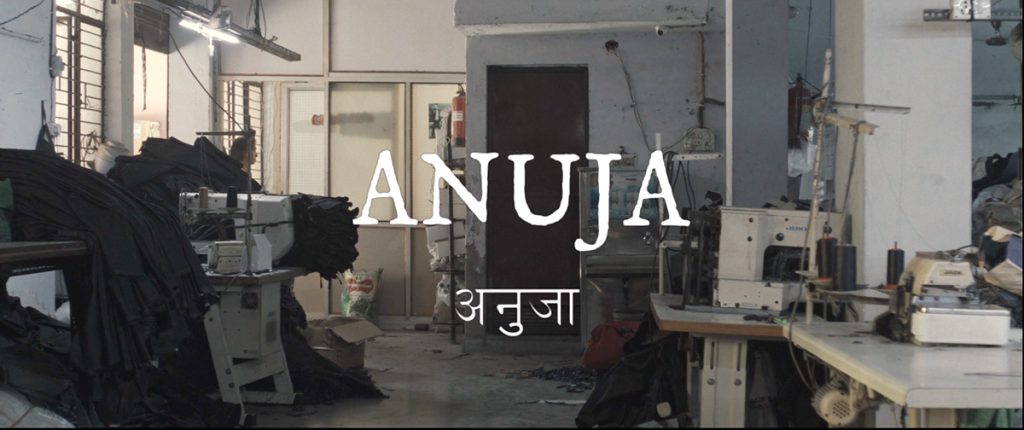
Anuja is a 9 year old street urchin slaving away in a grungy back-alley garment factory for pennies where her older sister also slaves away. They are orphans and are very close. Anuja’s older sister, very protective of her, is savvy and blessed with common sense; Anuja, too, is blessed; she is brainy, precocious.
Comes a time when out of the blue, so to speak, Anuja is serendipitously tapped on the shoulder by a boarding school official offering the precocious youth an enrollment opportunity. Anuja faces a choice – there’s a catch similar to a Catch 22 with a Hobbesian touch – that will determine her fate and that of her sister as well: Stay with sis? Enroll in the boarding school? Uh Oh?
Why Does This Reviewer Believe ANUJA Is a Gem of a 5-Star Film– Bittersweet As It Is – That Should be Seen More Than Once?
I thought the best way to write my Why was to explain Adam J. Graves’ reason for making the movie. I thought his Director’s Statement, with this reviewer using key excerpts, stylistic touches, paraphrases of direct quotes and other editorial touches of this publication, could hone in if not capture the magic of ANUJA. For example, there are details about how a film as rich in verisimilitude about street kids struggling to survive day by day avoids doesn’t result in the visceral pangs that could result in a story too depressing to attract audiences and rave reviews.
Director Graves was in the early stages of developing a coming-of-age film when his wife and producing partner Suchitra Mattai alerted him to an “unsettling statistic:” That is, nearly 1 in 10 children under 15 is subjected to child labor that is detrimental to their health, development, and education. {Unicef Child Labor Page}
Graves in his Director’s Statement: The figure seemed very real to us. Our own children were about that age and they (through my wife’s side of the family) are descendants of indentured laborers from the state of Uttar Pradesh in northern India. It was disquieting to think that this ancestral past was a living present for over 160 million children around the world.
He also wrote that news coverage after the Pandemic was voluminous about the global supply chain. Unsurprisingly, the coverage focused almost exclusively on the consumer-end of the story — on the scarcity of goods and the toll it was taking on the economic recovery. But the lack of attention to the supply-side of the story seemed to underscore just how easy it is for affluent communities to ignore their place in a global economic system that often contributes to the exploitation of labor, including child labor.
He and his wife at the time notice that many coming of age films eschewed info about the real-world lives of working children. There was an important story here, or rather an entire universe of stories waiting to be told. So, I dove headlong into the research on child labor, paying particular attention to sectors known to export products to wealthier nations.
Graves, in a sense, is embedded in South Asia where he has studied, benefited from funded research and net worked with several nonprofits. I was put in touch with NGOs that provide assistance to working children and their families, such as the Kailash Satyarthi Children’s Foundation and Work: No Child’s Business. This led me to visit the Salaam Baalak Trust, where I met with working (and formerly working) children, visiting their homes, observing their work, and meeting their families. Many of these children, mostly young girls, left school at a young age in order to help support their families.
He writes that it was not usual for him to meet “resilient, gifted and inspiring” young girls who faced many challenges because of their poor economic status. It was impossible not to be moved by their ability to find and to create joy amidst harsh realities. I felt it was important to make a film that was true to their experiences, but was also something they would want to watch and discuss themselves — one that drew from reality but without focusing excessively on the doom-and-gloom.
I wanted to capture that wondrous combination of magic and emotion, of innocence and mischief, which is part of childhood itself — these are kids after all, not statistics. Though every film is collaborative, this one was much more so than most. Were it not for the talent and support of the children of the Salaam Baalak Trust (especially our brilliant star, Sajda Pathan), we never could have brought this important story to the screen.
ANUJA opens with Anuja, played by Sajda Pathan, listening to her older sister Palak, played by Nagesh Bhonsle, telling a fairytale about a family – parents, their daughter and a pet mongoose – and misunderstandings and misinterpretations resulted in a cruel fate for the pet mongoose who was really a hero but slain by the dad who wrongly believed it had killed his daughter who turned out to be a very much alive. So much of what Graves wrote in his Director’s Statement is imbued what this reviewer regards as magic in so many ways cinematically. That helps explain how ANUJA is a 5+-star bittersweet film that should be seen many times.
Click Here for Part 2

Editor, Publisher Gregg W. Morris
Can be reached at gregghc@comcast.net, progreggwmorris@gmail.com